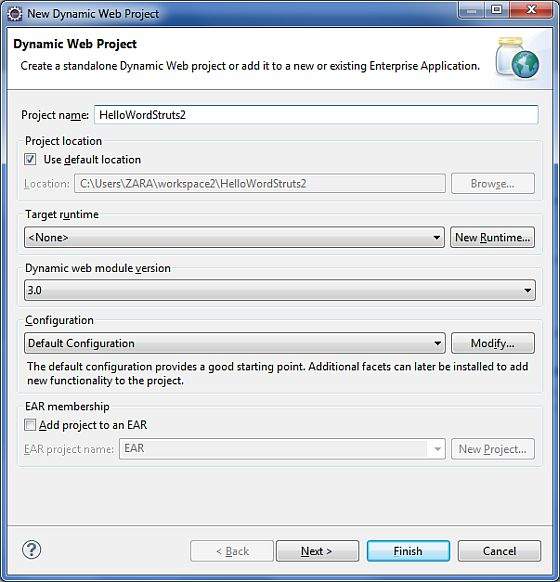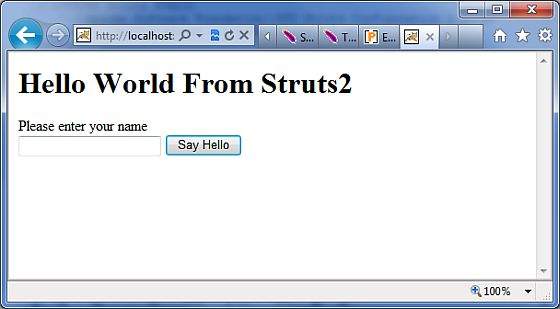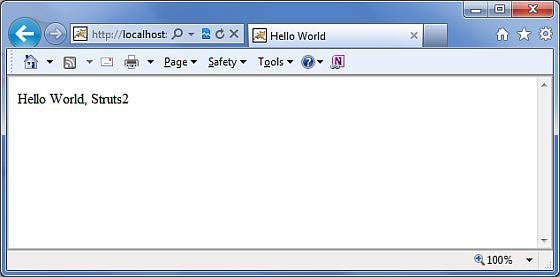Struts 2 - Hello World Example
As you learnt from the Struts 2 architecture, when you click on a hyperlink or submit an HTML form in a Struts 2 web application, the input is collected by the Controller which is sent to a Java class called Actions. After the Action is executed, a Result selects a resource to render the response. The resource is generally a JSP, but it can also be a PDF file, an Excel spreadsheet, or a Java applet window.
Assume you already build-up your development environment. Now let us proceed for building our first Hello World struts2 project. The aim of this project is to build a web application that collects the user's name and displays "Hello World" followed by the user name. We would have to create following four components for any Struts 2 project:
| SN | Components & Description |
|---|---|
| 1 | Action Create an action class which will contain complete business logic and control the interaction between the user, the model, and the view. |
| 2 | Interceptors Create interceptors if required, or use existing interceptors. This is part of Controller. |
| 3 | View Create a JSPs to interact with the user to take input and to present the final messages. |
| 4 | Configuration Files Create configuration files to couple the Action, View and Controllers. These files are struts.xml, web.xml, struts.properties. |
I am going to use Eclipse IDE, so all the required components will be created under a Dynamic Web Project. So let us start with creating Dynamic Web Project.
Create a Dynamic Web Project:
Start your Eclipse and then go with File > New > Dynamic Web Project and enter project name as HelloWorldStruts2 and set rest of the options as given in the following screen:

Select all the default options in the next screens and finally check Generate Web.xml deployment descriptor option. This will create a dynamic web project for you in Eclipse. Now go with Windows > Show View > Project Explorer, and you will see your project window something as below:

Now copy following files from struts 2 lib folder C:\struts-2.2.3\lib to our project's WEB-INF\lib folder. To do this, you can simply drag and drop all the following files into WEB-INF\lib folder.
commons-fileupload-x.y.z.jar
commons-io-x.y.z.jar
commons-lang-x.y.jar
commons-logging-x.y.z.jar
commons-logging-api-x.y.jar
freemarker-x.y.z.jar
javassist-.xy.z.GA
ognl-x.y.z.jar
struts2-core-x.y.z.jar
xwork-core.x.y.z.jar
Create Action Class:
Action class is the key to Struts 2 application and we implement most of the business logic in action class. So let us create a java file HelloWorldAction.java under Java Resources > src with a package name com.tutorialspoint.struts2 with the contents given below.
The Action class responds to a user action when user clicks a URL. One or more of the Action class's methods are executed and a String result is returned. Based on the value of the result, a specific JSP page is rendered.
package com.tutorialspoint.struts2;
public class HelloWorldAction{
private String name;
public String execute() throws Exception {
return "success";
}
public String getName() {
return name;
}
public void setName(String name) {
this.name = name;
}
}
This is a very simple class with one property called "name". We have standard getters and setter methods for the "name" property and an execute method that returns the string "success".
The Struts 2 framework will create an object of the HelloWorldAction class and call the execute method in response to a user's action. You put your business logic inside execute method and finally returns the String constant. Simply saying for for each URL, you would have to implement one action class and either you can use that class name directly as your action name or you can map to some other name using struts.xml file as shown below.
Create a View
We need a JSP to present the final message, this page will be called by Struts 2 framework when a predefined action will happen and this mapping will be defined in struts.xml file. So let us create the below jsp file HelloWorld.jsp in the WebContent folder in your eclipse project. To do this, right click on the WebContent folder in the project explorer and select New >JSP File.
<%@ page contentType="text/html; charset=UTF-8" %>
<%@ taglib prefix="s" uri="/struts-tags" %>
<html>
<head>
<title>Hello World</title>
</head>
<body>
Hello World, <s:property value="name"/>
</body>
</html>
The taglib directive tells the Servlet container that this page will be using the Struts 2 tags and that these tags will be preceded by s. The s:property tag displays the value of action class property "name> which is returned by the method getName() of the HelloWorldAction class.
Create main page:
We also need to create index.jsp in the WebContent folder. This file will serve as the initial action URL where a user can click to tell the Struts 2 framework to call the a defined method of the HelloWorldAction class and render the HelloWorld.jsp view.
<%@ page language="java" contentType="text/html; charset=ISO-8859-1"
pageEncoding="ISO-8859-1"%>
<%@ taglib prefix="s" uri="/struts-tags"%>
<!DOCTYPE html PUBLIC "-//W3C//DTD HTML 4.01 Transitional//EN"
"http://www.w3.org/TR/html4/loose.dtd">
<html>
<head>
<title>Hello World</title>
</head>
<body>
<h1>Hello World From Struts2</h1>
<form action="hello">
<label for="name">Please enter your name</label><br/>
<input type="text" name="name"/>
<input type="submit" value="Say Hello"/>
</form>
</body>
</html>
The hello action defined in the above view file will be mapped to the HelloWorldAction class and its execute method using struts.xml file. When a user clicks on the Submit button it will cause the Struts 2 framework to run the execute method defined in the HelloWorldAction class and based on the returned value of the method, an appropriate view will be selected and rendered as a response.
Configuration Files
We need a mapping to tie the URL, the HelloWorldAction class (Model), and the HelloWorld.jsp (the view) together. The mapping tells the Struts 2 framework which class will respond to the user's action (the URL), which method of that class will be executed, and what view to render based on the String result that method returns.
So let us create a file called struts.xml. Since Struts 2 requires struts.xml to be present in classes folder. So create struts.xml file under the WebContent/WEB-INF/classes folder. Eclipse does not create the "classes" folder by default, so you need to do this yourself. To do this, right click on the WEB-INF folder in the project explorer and select New > Folder. Your struts.xml should look like:
<?xml version="1.0" encoding="UTF-8"?>
<!DOCTYPE struts PUBLIC
"-//Apache Software Foundation//DTD Struts Configuration 2.0//EN"
"http://struts.apache.org/dtds/struts-2.0.dtd">
<struts>
<constant name="struts.devMode" value="true" />
<package name="helloworld" extends="struts-default">
<action name="hello"
class="com.tutorialspoint.struts2.HelloWorldAction"
method="execute">
<result name="success">/HelloWorld.jsp</result>
</action>
</package>
</struts>
Few words about the above configuration file. Here we set the constant struts.devMode to true, because we are working in development environment and we need to see some useful log messages. Then, we defined a package called helloworld. Creating a package is useful when you want to group your actions together. In our example, we named our action as "hello" which is corresponding to the URL /hello.action and is backed up by the HelloWorldAction.class. The execute method of HelloWorldAction.class is the method that is run when the URL /hello.action is invoked. If the outcome of the execute method returns "success", then we take the user to HelloWorld.jsp.
Next step is to create a web.xml file which is an entry point for any request to Struts 2. The entry point of Struts2 application will be a filter defined in deployment descriptor (web.xml). Hence we will define an entry oforg.apache.struts2.dispatcher.FilterDispatcher class in web.xml. The web.xml file needs to be created under the WEB-INF folder under WebContent. Eclipse had already created a skelton web.xml file for you when you created the project. So, lets just modify it as follows:
<?xml version="1.0" encoding="UTF-8"?>
<web-app xmlns:xsi="http://www.w3.org/2001/XMLSchema-instance"
xmlns="http://java.sun.com/xml/ns/javaee"
xmlns:web="http://java.sun.com/xml/ns/javaee/web-app_2_5.xsd"
xsi:schemaLocation="http://java.sun.com/xml/ns/javaee
http://java.sun.com/xml/ns/javaee/web-app_3_0.xsd"
id="WebApp_ID" version="3.0">
<display-name>Struts 2</display-name>
<welcome-file-list>
<welcome-file>index.jsp</welcome-file>
</welcome-file-list>
<filter>
<filter-name>struts2</filter-name>
<filter-class>
org.apache.struts2.dispatcher.FilterDispatcher
</filter-class>
</filter>
<filter-mapping>
<filter-name>struts2</filter-name>
<url-pattern>/*</url-pattern>
</filter-mapping>
</web-app>
We have specified index.jsp to be our welcome file. Then we have configured the Struts2 filter to run on all urls (i.e, any url that match the pattern /*)
Enable Detailed Log:
You can enabled complete logging functionality while working with Struts 2 by creating logging.properties file under WEB-INF/classes folder. Keep the following two lines in your property file:
org.apache.catalina.core.ContainerBase.[Catalina].level = INFO
org.apache.catalina.core.ContainerBase.[Catalina].handlers = \
java.util.logging.ConsoleHandler
The default logging.properties specifies a ConsoleHandler for routing logging to stdout and also a FileHandler. A handler's log level threshold can be set using SEVERE, WARNING, INFO, CONFIG, FINE, FINER, FINEST or ALL.
That's it. We are ready to run our Hello World application using Struts 2 framework.
Execute the Application
Right click on the project name and click Export > WAR File to create a War file. Then deploy this WAR in the Tomcat's webapps directory. Finally, start Tomcat server and try to access URL http://localhost:8080/HelloWorldStruts2/index.jsp. This will give you following screen:

Enter a value "Struts2" and submit the page. You should see the next page

Note that you can define index as an action in struts.xml file and in that case you can call index page as http://localhost:8080/HelloWorldStruts2/index.action. Check below how you can define index as an action:
<?xml version="1.0" encoding="UTF-8"?>
<!DOCTYPE struts PUBLIC
"-//Apache Software Foundation//DTD Struts Configuration 2.0//EN"
"http://struts.apache.org/dtds/struts-2.0.dtd">
<struts>
<constant name="struts.devMode" value="true" />
<package name="helloworld" extends="struts-default">
<action name="index">
<result >/index.jsp</result>
</action>
<action name="hello"
class="com.tutorialspoint.struts2.HelloWorldAction"
method="execute">
<result name="success">/HelloWorld.jsp</result>
</action>
</package>
</struts>
Struts 2 - Hello World Example的更多相关文章
- 菜鸟学Struts2——Struts工作原理
在完成Struts2的HelloWorld后,对Struts2的工作原理进行学习.Struts2框架可以按照模块来划分为Servlet Filters,Struts核心模块,拦截器和用户实现部分,其中 ...
- Struts的拦截器
Struts的拦截器 1.什么是拦截器 Struts的拦截器和Servlet过滤器类似,在执行Action的execute方法之前,Struts会首先执行Struts.xml中引用的拦截器,在执行完所 ...
- Struts框架的核心业务
Struts的核心业务 Struts核心业务有很多,这里主要介绍了比较简单一些的: 请求数据的处理,和数据自动封装,类型自动转换 1.Struts中数据处理 1.1.方式1:直接过去servletap ...
- Struts的文件上传下载
Struts的文件上传下载 1.文件上传 Struts2的文件上传也是使用fileUpload的组件,这个组默认是集合在框架里面的.且是使用拦截器:<interceptor name=" ...
- 配置hibernate,Struts。文件
hibernate文件配置 <?xml version="1.0" encoding="UTF-8"?> <!DOCTYPE hibernat ...
- hibernate与Struts框架结合编写简单针对修改练习
失败页面fail.jsp <%@ page language="java" contentType="text/html; charset=UTF-8" ...
- 3. 解析 struts.xml 文件
1. struts.xml 文件基本配置: 主要放在资源路径下,配置 sturts2相关的 Action , 拦截器等配置 <struts> <!-- 设置常量 --> < ...
- Struts+Spring+Hibernate项目的启动线程
在Java Web项目中,经常要在项目开始运行时启动一个线程,每隔一定的时间就运行一定的代码,比如扫描数据库的变化等等.要实现这个功能,可以现在web.xml文件中定义一个Listener,然后在这个 ...
- Struts 原理
今天开始接触公司的框架,叫YNA,三个字母应该是雅马哈的缩写,这个框架听公司前辈说功能很强大,但实际上我看不懂.哈哈...... 其中整合了SSH框架,接下来我说下Struts的一些原理 其实这张图就 ...
- axis2+struts拦截地址冲突问题
axis2和struts在整合过程中,struts会把axis的地址也拦截了,默认当成一个action处理, 会因为找不到action而报错: <!-- struts配置 --> < ...
随机推荐
- 支付宝当面付功能demo运行解读
下载java版本的sdk的demo: 然后拷入idea中: 准备工作: (1)验签工具下载:蚂蚁金服上面下载: https://openclub.alipay.com/read.php?tid=955 ...
- Python 函数01
Python 函数 函数是组织好的,可重复使用的,用来实现单一,或相关联功能的代码段. 函数能提高应用的模块性,和代码的重复利用率.你已经知道Python提供了许多内建函数,比如print().但你也 ...
- 进化论VS中性突变理论
进化论VS中性突变理论 查尔斯·罗伯特·达尔文(英语:CharlesRobert Darwin,1809年2月12日-1882年4月19日),英国生物学家,其“进化论”被列为19世纪自然科学的三大发现 ...
- getContentLength() 指为 -1 的解决办法
在这个坑里3个多小时啊.这里不得不抱怨下,国内的资料坑爹,全部copy不说,还是错的. 解决办法: 在服务端加入代码: File file = new File(path); //path为要下载的文 ...
- MyEclipse和Eclipse中jsp、html格式化自动排版问题
一.myeclipse的漂亮排版设置 步骤: 在左侧快捷 “搜索” 框里面输入 html . 点击选中左侧HTML Source . line - width 是设置当前行里面有多少字符时,就换行.这 ...
- C#: Delegate and Event
using System; using System.Collections.Generic; using System.Linq; using System.Text; using System.T ...
- ElasticSearch关键概念
Elasticsearch 添加索引 一个存储关联数据的地方 用来指向一个或者多个分片(shards)的逻辑命名空间(logical namespcase) 应用程序直接与索引通信 一个分片(shar ...
- elasticsearch-head插件安装说明
下载及安装readme https://github.com/mobz/elasticsearch-head 安装: npm install npm run start 访问:http://local ...
- serialize()传值缺失
思路:serialize()获取的是 " & " 拼接的字符串,无法传值,需要拆分后,拼接,生成新字符串,传过去. 例子: var v_idd = $("form ...
- 【navicat112_premium】navicat112_premium数据库连接工具安装过程
此工具及其方便,可以连接mysql.oracle.sqlserver登数据库... 1.下载安装包Navicat Premium_11.2.7简体中文版.rar 下载地址:http://qiaoliq ...
